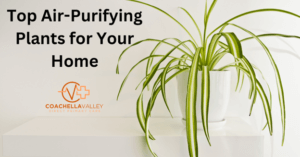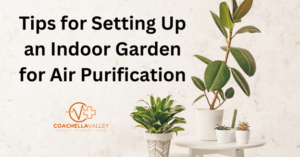Take a deep breath. What’s the quality of the air you’re breathing? Most of us spend the majority of our time indoors, yet we rarely think about the air we’re inhaling. Poor indoor air quality can trigger a range of health problems, from minor annoyances like headaches and fatigue to life-altering respiratory diseases.
Despite the importance of indoor air quality, many people are unaware of the potential risks and the steps they can take to improve the air they breathe. In this blog post, we’ll explore the various factors that contribute to indoor air quality, the health effects of poor air quality, and practical solutions for creating a healthier indoor environment.
Coachella Valley Direct Primary Care
Frustration-free health care for the whole family. A monthly membership program designed for the busy Coachella Valley family to give you direct access to primary healthcare services so you can be healthy and active. Schedule a free consultation. 760-642-5549
The Importance of Indoor Air Quality
Did you know that we spend about 90% of our time indoors? That’s a lot of time breathing in air that may not be as clean as we think. Indoor air quality has a huge impact on our health and well-being, and inadequate ventilation can lead to higher levels of indoor air pollutants.
Bad air inside can be a real health hazard, causing everything from headaches and fatigue to serious respiratory diseases and even cancer. And it’s not just anyone who’s at risk – it’s especially important for kids, older adults, and people with existing health problems to breathe easy.
Health Effects of Poor Indoor Air Quality
Air quality matters. When it’s poor indoors, you might experience a multitude of health issues. Itchy eyes, a stuffy nose, and a throbbing headache can make it hard to focus. And if you’re constantly exhausted, it’s hard to enjoy life to the fullest.
We’re not just talking about a slight cough or wheeze when it comes to indoor air pollutants. The risks are much more serious. Exposure to these pollutants has been linked to respiratory diseases, heart disease, and even lung cancer. And if you already have a health condition, these pollutants can make it much harder to manage.
Indoor Air Pollutants and Their Sources
So what exactly is polluting our indoor air? There are many sources of indoor air pollutants, including building materials, furniture, and household products. Some common culprits are:
- Volatile organic compounds (VOCs) from paints, cleaning products, and air fresheners.
- Formaldehyde from pressed wood products and certain insulation materials.
- Asbestos from older building construction materials.
- Radon, a radioactive gas that can seep into buildings from the ground.
- Carbon monoxide from fuel-burning appliances like gas stoves and furnaces.
- Dust mites, mold, and pet dander.
Ventilation, temperature, and humidity all play a significant role in determining pollutant levels. To breathe easy, you need to understand how these factors intersect and then take action to minimize pollutants with effective ventilation systems and air exchange strategies.
NASA Clean Air Study: Plants for Improving Indoor Air Quality
In the late 1980s, NASA conducted a study to find ways to clean the air in space stations. They discovered that certain common indoor plants can actually help remove hazardous air pollutants, including volatile organic compounds (VOCs) like formaldehyde, benzene, and trichloroethylene.
To breathe easier and boost environmental health, try adding some greenery to your indoor space. Research from the NASA Clean Air Study suggests that one plant per 100 square feet is all it takes to start cleaning the air and reducing exposure to indoor air pollutants.

Top Air-Purifying Plants for Your Home
If poor indoor air quality is taking a toll on your health, it’s time to call in the green team. Based on NASA’s study, these superstar plants are proven to remove air pollutants and leave your space feeling fresh and clean.
- Areca Palm
- Lady Palm (Bamboo Palm)
- Florists Chrysanthemum
- English Ivy
- Variegated Snake Palm
- Red-Edged Dracaena
- Peace Lily
- Boston Fern
- Spider Plant
Air quality indoors can be a real concern, but the solution might be simpler than you think. Introduce some air-purifying plants into your home or office, and you’ll be rewarded with cleaner air and a more natural ambiance.
How Plants Remove Air Pollutants
As plants breathe in, they suck up air pollutants through their leaves and roots. But that’s not all – the tiny critters living in the soil team up to break down toxins, creating a natural air cleaner that’s hard to beat.
During photosynthesis, plants pull in carbon dioxide and release oxygen. But they also absorb other gases, including VOCs, through their leaves. These pollutants then get broken down and used by the plant, or simply stored in the leaves, roots, and soil.

Tips for Setting Up an Indoor Garden for Air Purification
Ready to start your own indoor air-purifying garden? Here are some tips to get you started:
- Choose the right plants for your space, based on light availability and your level of plant care experience.
- Make sure you have enough plants – aim for one per 100 square feet at minimum.
- Use high-quality, well-draining potting soil.
- Choose pots with drainage holes to prevent overwatering and root rot.
- Dust the leaves regularly so they can absorb pollutants efficiently.
Choosing the Right Containers and Soil
When it comes to containers, choose materials like ceramic or terra cotta. Avoid plastic pots, as they can leach chemicals. Make sure the pots have drainage holes to prevent waterlogging.
For soil, opt for an organic potting mix free of synthetic fertilizers or pesticides. The microorganisms in the soil are crucial for breaking down pollutants, so avoid anything that could harm them. Larger leaves and well-established plants are more effective at removing toxic chemicals from the air.
Other Ways to Improve Indoor Air Quality
Beyond plants, there are plenty of other ways to breathe new life into the air quality in your home or office.
- Open windows regularly to allow fresh air to circulate.
- Use an air purifier with a HEPA filter.
- Vacuum and dust regularly to remove pollutants.
- Choose low-VOC or zero-VOC paints, furniture, and cleaning products.
- Test for radon and install a mitigation system if needed.
Minimizing Indoor Air Pollutants
To breathe easy, think prevention. Choosing low-emission products and materials from the get-go helps keep indoor air quality high and pollutants at bay.
Look for products labeled as low-VOC or zero-VOC, especially for things like paint, furniture, and carpeting. Choose solid wood instead of pressed wood products, which can emit formaldehyde. Opt for natural cleaning products instead of harsh chemicals to minimize exposure to harmful substances.
The Role of Ventilation in Indoor Air Quality
Good indoor air quality starts with proper ventilation. By bringing in fresh air and pushing out polluted air, you can enjoy a cleaner, healthier living space.
Make sure your home or office has adequate ventilation, either through natural means like windows or through mechanical systems like HVAC. Open windows regularly to let in fresh air, especially when using products that emit VOCs. Good ventilation helps reduce indoor concentrations of air pollutants.
Key Takeaway:
Boost indoor air quality by killing two birds with one stone: use plants like Areca Palm or Lady Palm to remove pollutants while adding a touch of nature to your space, and consider advanced options like HEPA air purifiers to trap 99.97% of particles as small as 0.3 microns, for a multi-pronged approach to fresher air.
Conclusion
Improving indoor air quality is essential for protecting our health and well-being. By understanding the sources of indoor air pollution and taking proactive steps to minimize their impact, we can create healthier living and working environments for ourselves and our loved ones.
Want to breathe easier at home? It starts with small changes. Regular cleaning, using natural products, and bringing in plants that purify the air can work wonders.
As we spend more time indoors than ever before, prioritizing indoor air quality has never been more important. By working together to raise awareness and implement solutions, we can create a future where clean, healthy air is a reality for all.

